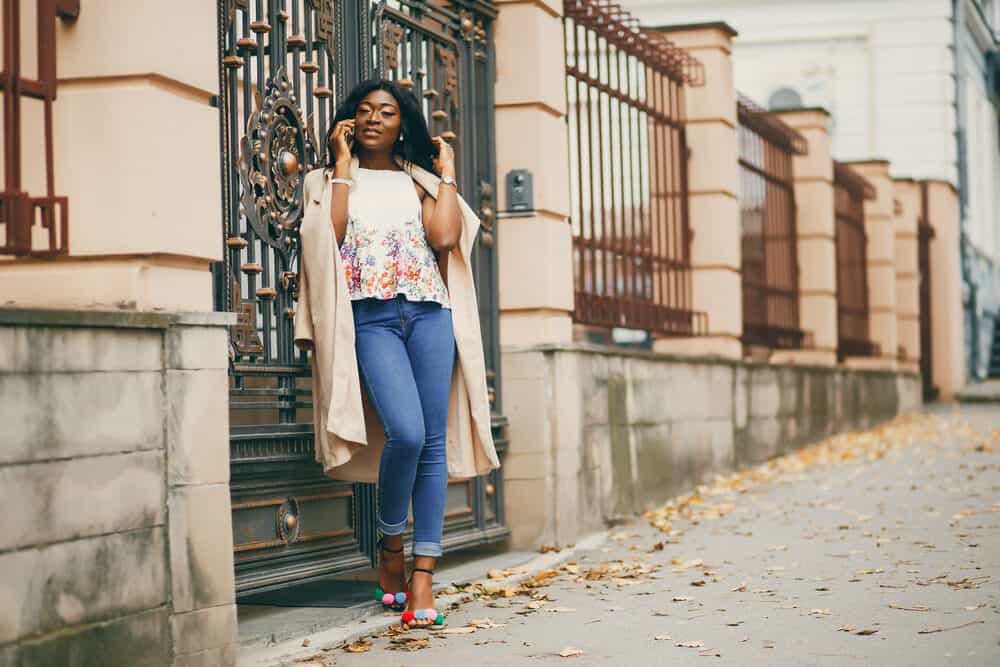
Glue-in weaves are super easy to do, but they carry a high risk of hair and scalp damage. That's why you should opt for glueless weaves.
Many people with short hair think that glue-in weaves are their only option, but that's just not the case. There are several glueless weaving methods that you can try, and we will cover all of them in this article.
Table of Contents
How To Do a Traditional Sew-In with Short Hair
Chances are you've heard of a sew-in before. It's the process of sewing weft extensions onto your braided natural hair.
The best thing about this weaving method is that it doesn't require the use of glue, so you don't have to worry about hair loss from clogged hair follicles or ripped-out edges.
To do a traditional sew-in, you'll need at least a few inches of hair, or at least enough hair to grab and cornrow.
Though the traditional sew-in is much better than glue-in extensions, it comes with a moderate risk of damage. However, when you know how to do a sew-in correctly, the risk of damage to your hair or scalp is greatly minimized.

Gather Your Materials
It is essential to gather all the materials you need before beginning a sew-in. You will need these materials:
- Extension hair bundles
- Lace closure (optional)
- Thread and curved needle
- Styling gel, cream, or mousse
- Hair scissors
- Shampoo
- Conditioner
- Moisturizer
- Rattail comb
- Mesh cap
- Alligator clips
Now that you have all of your supplies, it's time to get to sewing. You'll need to start with freshly washed, conditioned, moisturized, and blown-out hair.

Here are the steps to follow for the braiding and sewing process:
1. Use your rat tail comb to part out a U-shaped section of hair at the front of your head (your leave-out). You can also leave some hair out around the perimeter of your head to make the final result look more natural. You will style the leave-out portions after you sew in the extensions. But for now, twist them or clip them to get them out of the way.
Note: There’s a chance you may not be able to blend your short hair with the extension hair. In that case, you should opt for a lace closure, which makes it look like your hair is growing from your scalp. If you'll be using a closure, you won't need to make a U-part.
2. Divide the rest of your hair into half-inch sections, starting from the bottom of the U-shaped section and ending at the nape of your neck. If you'll be using a lace closure, cornrow all of your hair from front to back.
3. Reinforce the braids with weave thread and a curved needle. Flip the ends of the braids upwards before sewing them. This will help to prevent unraveling.
4. Place the
5. If you left hair out in the first step, use a flat iron, a styling gel, or rollers to style the hair. If you opted for a closure, sew it down on top of the braids in the front and then style all of the weave.
To see a demonstration of how a sew-in is done, watch the YouTube video above.
How To Do a Braidless Sew-in
The braidless sew-in is another glueless weaving option that's great especially for short hair. As its name suggests, you will not have to do any cornrows to anchor your weave.
Instead, you'll use a twisting and sewing technique that creates a base for the weave to be sewn upon.

Gather Your Materials
To get started, you'll need the following supplies:
- Extension hair bundles
- Synthetic braiding hair
- Thread and curved needle
- Styling gel, cream, or mousse
- Hair scissors
- Shampoo
- Conditioner
- Deep conditioner (optional)
- Moisturizer
- Rattail comb
- Alligator clips
It's time to get into the weaving process. Before you get started, as with the previous method, you should start with freshly washed, conditioned, moisturized, and dry natural hair.

Follow these steps to do a braidless sew-in:
- Begin by parting a ½-inch section of hair near your ear. The part should extend from the front of your head to the nape of your neck. Use a few alligator clips to keep the rest of the hair out of the way.
- Grab a half-inch section of braiding hair and began doing a flat twist.
- Part out a quarter-inch section of hair at the beginning of the section you just created.
- Separate the section into two and then lay the extension hair on top of it.
- Combine each half of your natural hair with the braiding hair and twist each part inward a few times.
- Group the sections together and begin twisting it all in one direction. As you twist the hair in the direction of the part, grab more and more of your natural hair.
- Once you've twisted the hair about an inch down, get your needle and thread and begin to reinforce the twist with it. Go under the twist with the needle and then create a knot on top. Continue doing this as you twist.
- When you get to the end of the twist, three-strand plait the hair down to the ends.
- Repeat this step all over your head until all your hair is twisted and sewn.
- Put on a mesh cap, and then sew it onto your twists.
- If your hair is extremely short, it may not blend well with the extension hair. In that case, you should use a closure, which mimics the look of hair growing out of your scalp. The closure should be sewn down at the front of the mesh cap in the middle.
- Place the
hair extensions on top of the mesh cap (following the contours of your head) and stitch them in place with your needle and thread. After every couple of stitches, tie a knot in the thread. You may need to cut a weft here and there to get it to lay flat. - Style the extensions and/or your hair.
Watch the video above to see a braidless sew-in done step by step.
How To Install Braid-in Bundles
Braid-in bundles are much easier to work with than regular weft bundles. The braid-in bundle technique requires you to braid specialized weft extensions, called braid-in bundles, into your natural hair.
Just like the other techniques we've mentioned, you should start off with clean, dry natural hair. You can also blow out your hair to make it easier to work with.

Gather Your Materials
Here's what you'll need to get started:
- Braid-in Bundles
- Synthetic braiding hair
- Styling gel, cream, or mousse
- Hair scissors
- Shampoo
- Conditioner
- Deep conditioner (optional)
- Moisturizer
- Rattail comb

Here's how to weave short hair with braid-in bundles:
- With a rat tail comb, part out a 1-inch horizontal section of hair at the nape of your neck.
- Grab a small section of synthetic braiding hair and braid it in with your natural hair. Start at one end of the section.
- After braiding for about half an inch, unwrap one of your braid-in bundles. Then begin braiding the hair sticking out of the top of the weft in with your natural hair and the synthetic braiding hair.
- Continue braiding and adding hair from the braid-in bundle until you get to the end of the horizontal section.
- Repeat the previous 2 steps, moving upward. Follow the contour of your head as you part your hair and braid in the braid-in bundles.
- Feel free to leave out some of your hair at the front if it's long enough. But if it isn't, you could sew a lace closure onto the braids near the crown of your head. This part is optional, though.
- Use your styling products and tools to straighten, curl, or set your weave.
If you're more of a visual learner, we recommend that you watch the video demonstration above of a braid-in bundle installation.
- How Do Hair Extensions Work on Short Hair
- Best Weave To Blend With Natural Hair
- Best Human Hair Extensions for Sew In
- Are Hair Extensions Bad for Your Real Hair
- Best Hair Extensions for Very Short Hair
Conclusion
With the three weaving options presented in this article, you can enjoy sleek, natural weaves without glue. We hope that the tips and instructions are helpful to you as you switch up your hairstyle in a fresh, new way.




